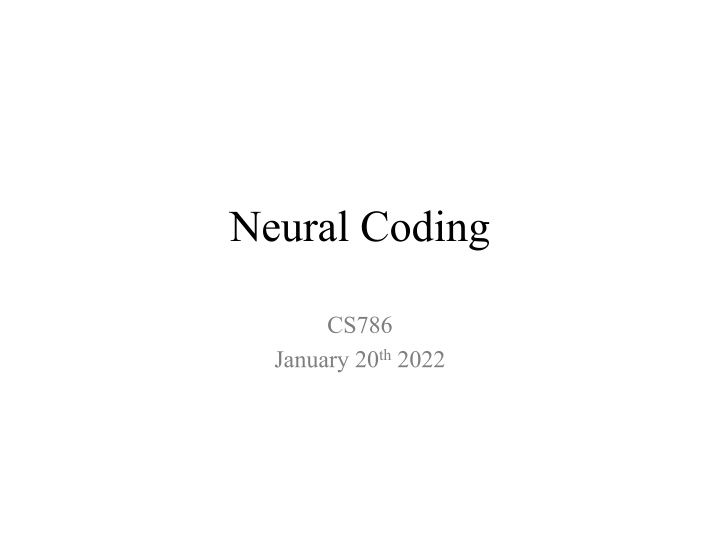
Neural Coding and Neurocomputing Fundamentals
Explore the intricate details of neural coding, neurophysiology, neurocomputing, tasks, architectures, and learning mechanisms in the field of computational neuroscience. Discover how neurons, synapses, and networks work together to process information efficiently.
Download Presentation

Please find below an Image/Link to download the presentation.
The content on the website is provided AS IS for your information and personal use only. It may not be sold, licensed, or shared on other websites without obtaining consent from the author. If you encounter any issues during the download, it is possible that the publisher has removed the file from their server.
You are allowed to download the files provided on this website for personal or commercial use, subject to the condition that they are used lawfully. All files are the property of their respective owners.
The content on the website is provided AS IS for your information and personal use only. It may not be sold, licensed, or shared on other websites without obtaining consent from the author.
E N D
Presentation Transcript
Neural Coding CS786 January 20th2022
Neurophysiology Summary Neurons Synapses Nucleus Axon Dendrites Dense: Human brain has 1011neurons Highly Interconnected: Human neurons have 104fan-in. Neurons firing: send action potentials (APs) down the axons when sufficiently stimulated by SUM of incoming APs along the dendrites. Neurons can either stimulate or inhibit other neurons. Synapses vary in transmission efficiency Development: Formation of basic connection topology Learning: Fine-tuning of topology + Major synaptic-efficiency changes.
NeuroComputing wi wj wk Nodes fire when sum (weighted inputs) > threshold. Other varieties common: unthresholded linear, sigmoidal, etc. Connection topologies vary widely across applications Weights vary in magnitude & sign (stimulate or inhibit) Learning = Finding proper topology & weights Search process in the space of possible topologies & weights Most ANN applications assume a fixed topology. The matrix IS the learning machine!
Tasks & Architectures Supervised Learning Feed-Forward networks Concept Learning: Inputs = properties, Outputs = classification Controller Design: Inputs = sensor readings, Outputs = effector actions Prediction: Inputs = previous X values, Outputs = predicted future X value Learn proper weights via back-propagation In Out Unsupervised Learning Pattern Recognition Hopfield Networks Excitatory & Inhibitory Arcs in the Clique In Out Data Clustering Competitive Networks Maxnet: Clique = only inhibitory arcs In Out
Learning = Weight Adjustment wj,i xi zj xj Generalized Hebbian Weight Adjustment: The sign of the weight change = the sign of the correlation between xi and zj: wji xizj zj is: xj dj - xj dj - xiwji i Hopfield networks Perceptrons (dj = desired output) ADALINES
Local -vs- Distributed Representations Assume examples/concepts have 3 features: Age : {Young, Middle, Old} Sex: {Male, Female} Marital Status: {Single, Dancer, Married} Young, Married Female! Old, Female Dancer! Young, Single, Male! Old Female! Samboer! Distributed: Together they rep a conjunctive concept, but the individual conjuncts cannot necessarily be localized to single neurons Semi-Local: Together they rep a conjunctive concept, and each neuron reps one or a few conjuncts - i.e. concept broken into clean pieces. Local: One neuron represents an entire conjuctive concept.
Local -vs- Distributed (2) Size requirements to represent the whole set of 18 3-feature concepts - assuming binary neurons (on/off) Local: 3x3x2 = 18 Instance is EXACTLY 1 of 18 neurons being on. Semi-Local: 3+3+2 = 8 (Assume one feature value per neuron) Instance is EXACTLY 3 of 8 neurons being on. Distributed: log2 18 = 5 Instance is any combination of on/off neurons Add 1 bit and DOUBLE the representational capacity, so each concept can be represented by 2 different codes (redundancy). The same neural network (artificial or real) may have different types of coding in different regions of the network. Young Old Single Married Male Female +5 Young, Married Female! +1 +3 Semi-Local => Local
Representational Hierarchies In the brain, neurons involved in early processing are often semi-local, while neurons occuring later along the processing path (i.e. higher level neurons), are often local. In simpler animals, there appears to be a lot of local coding. In humans, it is still debatable. Line tilted 45o @ {3o,28o} Dark dot @ {3o,28o} Grandma!! Human Face
